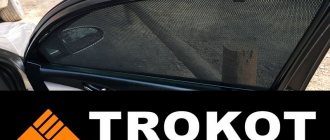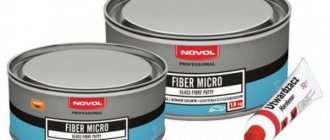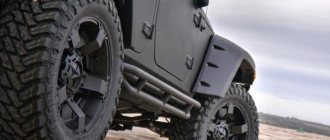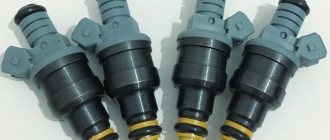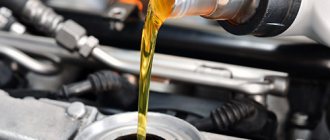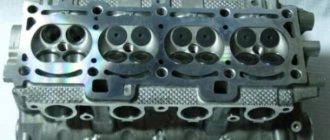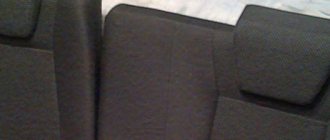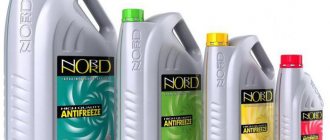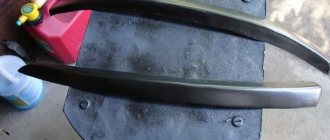Welcome to the kuzov.info blog!
In this article, we will look at the main types of automotive putties, their properties and features, and in what cases they should be used.
To begin with, let us clarify the peculiarity of the very name of this composition, since in one of the articles in the comments there was some controversy about this. This repair material, in Russian, can be called both “shpaKlyovka” and “shpaTlyovka”. Both words are correct; more details about the occurrence and application of these words can be found in dictionaries. Briefly, we can say that the word “shpaKlyovka” is more Russian (from the word to paklevat, that is, to seal holes and cracks), generally accepted and more often used in colloquial speech. The word “putty” is of foreign origin (from the German word spatel) and is more specialized. Both words can be found on the packaging. On automobile containers the word “putty” is more often used. I am more accustomed to using the generally accepted colloquial form of this composition, so I will use the words “shpaKlyovka” and “shpaKlevat” in this article.
Modern equipment and the professionalism of a body repair specialist sometimes makes it possible to level a damaged panel to a state that does not require the use of putty. It also happens, on the contrary, that unscrupulous and unskilled craftsmen hide traces of poor-quality repairs and rust under a thick layer of putty, giving this material a bad reputation.
When used correctly, in the right quantities, car putty is a good product that makes repairs easier. In fact, even some new cars have putty. Sometimes minor damage occurs during the production and assembly process on the assembly line and minimal use of putty is acceptable.
Automotive putty contains polymer, talc, various additives that improve its properties and a small amount of styrene, which acts as a thinner and evaporates. Depending on the type and purpose of the putty, in addition to talc, it may contain other fillers, which we will consider later in this article. The polymer in the car putty reacts chemically with the hardener, releasing heat. Talc and other fillers are inert (do not react), they provide mass to the putty, which can then be processed.
Background
Putties began to be widely used in the late 50s. Until then, low-melting solders were used to fill dents and level surfaces. First, the part was straightened using a hammer and a backing stamp (remember, the body metal used to be much thicker), then the damage was filled with solder brought to a malleable state with a blowtorch, and the final adjustment to the shape was performed with special files.
This process is painstaking, low-tech and lengthy, which is absolutely not in the spirit of our time. Additionally, working with open flames and molten solder in a garage full of tin dust poses a health hazard to workers. And if in the 50s they did not pay much attention to this, in our time the safety requirements have become more stringent.
It's no surprise that the paste-like material, which can be quickly and easily mixed, applied and molded without heat or special equipment, has quickly gained popularity...
Putty quality
The quality of the putty is influenced by the quality of its components. Putties from different manufacturers may use different quality binder polymers, different sizes of talc particles and quartz microspheres, and may also contain various chemical additives. The quality of the putty can determine the ease of its application, sanding, whether the sanding paper will clog, the presence of pores after hardening, as well as the degree of shrinkage. A good putty should have excellent adhesion to the surface and minimal shrinkage after complete hardening.
What is putty?
Based on GOST 28246-89, which establishes paint and varnish terminology:
Putty is a product of paste or liquid consistency used to remove minor surface defects before painting.
Any putty is a mixture of fillers and pigments (the former are responsible for filling properties, strength, ease of processing, degree of shrinkage, elasticity, the latter - for color) with a binder (responsible for adhesion to the surface, polymerization rate, the same degree of shrinkage, strength and elasticity) and various additives (plasticizers, stabilizers, etc.).
Nowadays, polyester putties (PE) have become overwhelmingly widespread in body repair (based on the chemical basis of the binder). Compared to putties based on acrylic and nitro bases, polyester ones have the least shrinkage (with a relatively large thickness of the applied layer) and the highest polymerization rate.
However, many craftsmen are not even aware of the existence of other putties - the popularity of polyester putties is so great today.
Criterias of choice
The composition is selected taking into account the following circumstances:
- The nature of the damage is through or blind.
- Heights of unevenness.
The choice also depends on what surface you plan to repair. Purchase a paste with good adhesion to this material.
Pay attention to the following parameters of the repair composition:
- Curing time.
- Minimum application temperature.
- Issue date and expiration date.
- Storage conditions.
- Porosity, grindability.
- Price.
Expensive compounds are easy to use and provide a durable, smooth coating.
Types of polyester putties
Surface leveling consists of two stages: filling and finishing. First, preliminary leveling is performed, “filling up” deep irregularities, after which the final finishing of the surface is performed.
According to this principle, all putties are divided into two large groups:
- filling;
- finishing
The Russian language is broad and multifaceted, so when talking about putties you can hear many different variations of their names. For example, filler putties are also called coarse, basic, heavy; finishing - finishing, finishing, soft, thin...
One thing is clear: filling putties quickly fill deep unevenness. However, most often such putties have a coarse-grained structure and are not capable of creating a smooth, non-porous surface (for example, fiberglass putty). Therefore, they require subsequent application of finishing putties.
Lapping putties are fine-grained materials. They are flexible, easy to apply and easy to sand. On the one hand, they are used as a finishing material after coarse-grained putties, on the other hand, as an independent material for eliminating minor defects.
There are also universal putties that have the properties of both filling and finishing at the same time. Different materials are also used for application to metal and plastic.
According to the method of application, putties can be highly viscous, applied with a spatula, and liquid - “under a gun” (they also go under a brush).
To understand which putty is best used for which types of work, let’s take a closer look at the properties of the main types of putties offered by leading manufacturers of repair materials.
Fillers reinforced with glass fiber (Glass, Fiber, Fiber)
If you need to restore a rusted or heavily deformed part, use putty reinforced with fiberglass. Additives of short chopped fiberglass give this putty high strength and reinforcing properties, as well as high filling ability - this putty can be applied in thick layers, quickly eliminating very deep unevenness. The same putty is used in cases of sealing various through damage to a part, places where metal breaks. Glass fibers here play the role of a kind of reinforcing bridges, preventing the material from falling over empty spaces.
Although this putty is durable, it is still not recommended to use it on large surfaces where the metal “plays” a lot (for example, the central part of the roof), since although it is strong, it is not elastic enough and can crack during vibration. Ideal places are sills, pillars, arches and other “power” areas of the car body.
Fillers reinforced with aluminum (Alu, Aluminum)
If it is necessary to correct defects on surfaces exposed to temperature and vibration (roof, hood, engine compartment), it is recommended to use metallized putty. Thanks to the aluminum powder filler, this putty has a thermal expansion coefficient close to that of metal, which allows it to withstand temperature changes well without cracking or peeling.
Despite its filler status, this putty has a fine-grained structure and can also be used to eliminate small defects. At the same time, it is ideally brought to zero, without chipping at the putty boundary, which is typical for medium- and coarse-grained materials.
Also, this putty is the least susceptible to shrinkage: aluminum is simply unable to absorb large amounts of solvent (the evaporation of which causes shrinkage).
Other advantages include the longer life of this putty compared to others - up to 8 minutes (others up to 5 minutes), which plays into its favor when working on large surfaces.
Lightweight fillings (Leicht, Light, Alloyd)
Surely many have encountered a situation where lifting the hood becomes an activity akin to weightlifting. Just in cases where the volume of work is large, and the increase in the weight of the part should be unnoticeable, lightweight putty is recommended. This putty is lighter than usual by as much as 30-40%!
Such a low specific gravity is ensured by a special filler - most often these are microscopic hollow glass beads. In addition to low weight, this also makes the putty easy to grind, since the grinding process does not involve “pulling out” the filler from the resin, but only destroying the glass beads, which is much simpler. In addition, such putty does not “petrify” and is equally easy to process even after 30 minutes or after 3 days.
All this makes lightweight putty an ideal filling material when working on large surfaces (panels of cars, buses, carriages, etc.) that need to be quickly sanded.
Filling classic (Full, Soft)
“Ordinary” filling putties can serve as a base material for leveling surfaces. They have excellent filling properties and excellent sandability, making them ideal for continuous filling of surfaces and their further removal using a plane.
When eliminating very deep defects, such putty can be applied to fiberglass putty without preliminary sanding (it is not recommended to sand the latter at all, since harmful dust can enter the respiratory system). Most often these are medium-grain materials, so to achieve maximum surface quality they must be covered with fine-grain finishing putty.
Finishing (Fein, Finish)
Finishing putties have a creamy consistency and fine structure, making them easy to apply and not leaving pores. They are elastic and excellent for sanding, serve as a finishing material after using coarse-grained materials (fiberglass, filler, lightweight), and also as an independent material for eliminating small defects (scratches, pores, small dents).
Lapping putties are white in color, which makes it easier to control the quality of the surface when using dry development during grinding.
Universal (Multi, Uni, Universal)
The name speaks for itself. Universal putty is a multifunctional material with a wide range of applications. Such putties, firstly, have excellent adhesion to all types of surfaces found in body repair, including aluminum, galvanized, steel, plastic, fiberglass (hence their name).
Secondly, they can be used both to obtain relatively thick layers and thin ones. After drying, they have high elasticity and excellent sandability.
Liquid (Spray)
Spray putty can be an effective means of eliminating a large number of small defects on large surfaces. Due to its high solids content, it has good filling properties and allows you to quickly “fill” all minor defects on the surface. Dries quickly and is easy to sand, guaranteeing an absolute absence of pores on the surface.
It must be remembered that despite the method of application, this putty remains the same polyester putty, which means it needs to be covered with a filler primer.
For plastic (Flex, Plastic, Bumper Fix)
To eliminate defects on plastic parts (bumpers, spoilers, places where plastic elements are soldered and glued together), special plastic putties are used. They are based on a mixture of resins with crushed particles of rubber and plastic, which provides such putties with the highest elasticity and adhesion to plastic parts.
From the above, the conclusion suggests itself that a car painter’s cabinet should have at least three types of putties: one filler, one finishing and one for plastic.
Which putty to choose for car body treatment
If you plan to do your own body repairs, we recommend paying attention to polyester mixtures. This is a typical two-component composition that is prepared by adding a hardener to the resin.
The main advantage of such leveling putties compared to one-component ones based on nitrocellulose/acrylic fillers is minimal shrinkage and short polymerization time.
Epoxy putties, despite obvious disadvantages (duration of polymerization and difficulties with grinding due to the high strength characteristics of the composition), are also popular, especially on older cars, due to their pronounced anti-corrosion properties.
Acrylic pastes are mainly used to smooth out small defects.
If the dents are deep, two types of putties are usually used: coarse-grained for rough filling and finishing for finishing.
If you need to level a large area of a body with minor defects, use liquid compounds - they are easy to apply and obtain a perfectly flat surface.
If, thanks to these tips, you have finally decided which putty to fill your car with, here are a few tips that will help you avoid common mistakes:
- Before use, be sure to mix the composition thoroughly. Due to long-term storage, the filler usually settles to the bottom, and a frozen film forms on top. If you ignore this recommendation, the composition will be heterogeneous and with different strength characteristics;
- if you use several putties, wipe the tool before working with a specific composition - many compositions are incompatible with each other, especially from different manufacturers;
- to level large flat surfaces, it is better to use a facade spatula, which will help control the evenness of the applied layer;
- when stirring the mixture, try to prevent air from entering the solution - this will lead to the formation of internal cavities and a decrease in the strength of the putty;
- if work is carried out in the heat, when using two-component compounds, the proportion of hardener must be halved compared to the recommended one;
- if you need to thicken the putty, this can be done by adding fiberglass;
- After finishing work, be sure to wipe the tool dry - if the mixture dries out, you won’t be able to get a smooth surface next time.
Happy body repair!
The composition of putties and the problem of their shrinkage
Polyester putties consist of a modified unsaturated polyester resin and filler. To give the putty a working viscosity, the mixture of these components is dissolved with styrene. Thus, all consumer characteristics of a particular putty depend on the quality and properties of the resin and filler, as well as on the amount of solvent added.
Resin . Resin is the main component that determines the quality of the putty. It is responsible for ensuring adhesion to the surface being repaired, drying time, strength characteristics, and ease of processing.
The highest quality resins are considered to be products from the chemical concerns Bayer and BASF. If raw materials from these manufacturers were used in the production of putty, you can be sure of the high quality of such putties.
Fillers . Initially, these are solid inert substances of a certain size, insoluble in binders and solvents. Since the advent of polyester putties, finely ground rock powders have traditionally been used as fillers: chalk, talc, asbestos (prohibited), kaolinite, gypsum, etc.; later they began to use wollastonite and bentonite, and a few years ago they began to use quartz microspheres and phenolic microspheres.
The size and properties of filler particles directly affect the properties and purpose of the putty. For example, aluminum powder improves the thermal conductivity of the material, fiberglass additives give the putty reinforcing properties, and glass microgranules provide low specific gravity and easy sandability.
Solvent . Styrene, which is part of the polyester resin (very harmful to human health), participates in the polymerization reaction and partially evaporates, is one of the main components that affects one of the most important properties of the putty - shrinkage (reduction in volume during the polymerization process).
The optimal amount of solvent in the putty is considered to be 30% of its volume. Putties with a large amount of solvent are cheaper, but have greater shrinkage. After all, when the putty dries, the solvent evaporates from it, thereby reducing its volume. And the more solvent evaporates, the stronger the putty will shrink.
For this reason, the thickness of the applied putty layers should be as minimal as possible and it should be determined by the shrinkage parameter of the material. That is, if we take into account that high-quality putties shrink by about 2%, the material must be applied in layers of such thickness that a decrease in volume by 2% is not noticeable.
Other factors can also affect the shrinkage of the putty and the appearance of the putty area, for example, the method of processing the old paintwork before puttying.
So, if the boundary between the metal and the old coating is smooth, the shrinkage in this place will be only 2 microns (2% of 100 microns). In the event of a sudden break, the shrinkage will be as much as 20 microns (2% of 1 mm).
The method of processing old paintwork before puttying and its effect on shrinkage: a) smooth bevel; b) a sharp break
The method of applying the putty can also affect the subsidence of the putty. For example, if the application force is not strong enough, then deep grooves will leave voids into which the putty will fall later.
No less important is the issue of secondary shrinkage, which arises due to the influence of solvents from paint and varnish materials applied on top of the putty (liquid putty, filler primer). Secondary shrinkage is characteristic of cheap putties, the low-quality components of which allow solvents to penetrate deep into its layer. Then, during drying, this solvent evaporates, which causes the putty to gradually “compact”.
This problem can also be aggravated by poor-quality soils with low solids and aggressive solvents in their composition. Such a primer can dissolve the putty layer and lead to its further shrinkage, while the poor filling ability of the primer will not allow this defect to be smoothed out by grinding.
There can be only one conclusion here: you need to strictly adhere to technology and give preference to high-quality, proven materials. We will talk about putty technology in the next article, but as for the quality of putty... There is one simple way to check this: really high-quality putty cannot be cheap.
Surface preparation
At the first stage, it is necessary to prepare the surface for subsequent processing. To do this, thoroughly clean the car from dirt and dust and examine its surface for the presence of protruding bumps (putty is not able to hide such serious defects). If there is a raised bump, press the surface of the bump slightly and make sure that it does not return to its original position after applying the leveling compound.
Puttying these types of areas requires special skills, so it is better to contact a specialized center to fix the problem. If you nevertheless decide to putty the car body with your own hands, then you need to remove the protrusion as carefully as possible, especially for subsequent partial painting of the surface.
Next, you need to remove the top paint layer and rust using coarse sandpaper to ensure a more reliable fixation of the putty. Removal of paint should only be carried out on the putty area, and it is advisable not to touch the nearest surface.
Important! We recommend cleaning the surface from the paint until clean, shiny metal appears.
Summary
- For standard repairs, it is recommended to use filling putties, while coarse and medium-grained materials should be covered with fine-grained finishing putty.
- Putty with fiberglass is recommended to be used to fill the deepest possible irregularities, various holes, places of metal rupture, and through corrosion. It is not advisable to apply it to those body elements where there is strong vibration (for example, the roof). Ideal - sills, arches, pillars;
- in places subject to vibration and temperature changes (hoods, roofs), it is recommended to use putty reinforced with aluminum;
- in places with a large volume of work, where the increase in the weight of the part should not be noticeable, it is recommended to use lightweight putty as a filler;
- liquid putty is applied by spray and used as a finishing putty on large areas;
- To repair plastic parts (bumpers, spoilers), plastic putty is used. To eliminate small scratches and chips on plastic elements, you can also use fine-grained finishing putties;
- For work on aluminum and galvanized surfaces, it is recommended to use a universal putty, which provides high adhesion to these types of substrates. Other putties can only be used on these surfaces if specified in the technical description or the surface has been previously primed with epoxy primer.
The best manufacturers of automotive putties
As in any other area, it is advisable to purchase compounds produced by well-known manufacturers, whose products have earned praise from experts and ordinary motorists.
Here is a small list of such brands:
- Carfit. The company produces a lot of mixtures, and the best putty is Soft paste, which has a lightweight structure (hollow balls of plastic or glass are added to the mixture);
- Novol. Domestic car enthusiasts are best known for the Fiber line of fiberglass putties;
- DuPont. A well-known brand, the finishing mixture 791R is considered very good;
- CAR Fit. All putties from this manufacturer are good, especially the Spray family;
- ICR. A very popular liquid composition from this brand is Sprint 2K HS Spray, which is highly elastic, but does not spread even on inclined surfaces with a large gradient;
- Roberlo. The most famous mixture of this company is A80, which is recommended for use for treating microcracks;
- Chamaleon. This manufacturer's product range includes putties of almost all varieties.
All brands on the list have compositions with large and fine grains for processing body parts with defects of different structures.
11th position. Set (putty, hardener) HB BODY Proline 617
With this polyester filling putty, even large areas of the body surface can be easily repaired. Can be applied to all types of metals. The composition creates a durable, elastic and resistant coating.
Set (putty, hardener) HB BODY Proline 617
| Characteristics | |
| Blend color | Green |
| Type | Auto putty |
| Chem. compound | Polyester with fiberglass added |
| Number of components | 2 |
| Minimum application temperature | +10 °C |
| A country | Greece |
A balanced concentration of polyester resins and fiberglass ensures easy and uniform application of the mixture. Layers of putty dry quickly enough, the finished coating is easily processed with various sanding tools: a machine, abrasive paper.
It is permissible to use the putty mixture on parts of the body that are susceptible to corrosion. The coating gives minimal shrinkage. The composition is prepared in the ratio: 2% hardener to 100% putty. The coating must be applied within 3-5 minutes (at +20 °C) after preparation. It is important not to exceed the dose of hardener.
Universal mixtures
Universal putties are suitable for all cases. Of course, the surface “repaired” with the help of such a composition is inferior in most respects to the one that was repaired with the help of several highly specialized putties. And, nevertheless, for undemanding cases and quick restoration of damaged parts, putty marked with the words “Multi”, “Universal” or “Uni” will be sufficient.
Coarse filler mixtures
Coarse fillers are designed to fill deep dents. Due to the fact that they contain powder with large grains, the plastic composition is prone to porosity. For this reason, after filling defects with filler material, treat the surface with a finishing compound.
Popular classic filling putties are indicated by the inscriptions “Full” or “Soft”. They have good fillability and are easy to grind, which allows you to “remove” the planes using the method of continuous putty using a plane. Ease of processing allows the Soft composition to be used over coarser putties without preliminary sanding (when using fiberglass compounds, the dust from which poses a respiratory hazard).
It is advisable to use filling putty, reinforced with aluminum powder, on those body parts that experience increased temperature and vibration loads - on the roof, hood, trunk lid and in the engine compartment. Due to the presence of a metallized filler, the coefficient of thermal expansion of the mixture approaches that of steel. For this reason, auto putty with the inscriptions “Alu” or “Aluminium” is able to withstand numerous cycles of temperature changes without cracking or peeling off from the base.
How to prepare putty?
It is necessary to mix the putty strictly following the technology specified in the instructions. The simplest method of preparation is for compositions with fiberglass, since there is no possibility of spoiling the hardener or introducing air during mixing. Polyester putty mixture, on the contrary, requires high concentration. When breeding it, you should adhere to the following tips:
- The hardener is added in a proportion of 1.5-2% of the total mass of the putty.
- When smearing, a special technology is used (you can learn from videos on the Internet).
- The so-called “smearing” into the spatula is carried out so that air does not get into the solution (otherwise the putty will become porous).
On the video: how much hardener should be added to the putty.
Types of auto putties
Depending on the method of application to the car body, modern putties are divided into plastic and liquid mixtures. The first ones are applied with a spatula and allow you to level out deep dents and eliminate the most noticeable damage. They are divided into coarse-grained and finishing, which allows the formation of a multi-layer structure of the required thickness and degree of smoothness.
Liquid mixtures are used for finishing leveling of large surfaces and are intended for spraying with a special gun. If we talk about the full classification, then to restore the appearance of body parts the following types of automotive putties are used:
- Fillers (fillers).
- Mixtures with reinforcement function.
- Fine-grained finishing compounds.
- Universal.
- Designed for repairing plastic body elements.
- Putties that are applied by spraying.
In addition, finishing materials differ in composition and base material. Polyester two-component automotive putty, which includes a base and a hardener, has become widespread. It dries quickly and is easy to work with, but this mixture cannot be applied to paint or anti-corrosion primer. For these purposes, a two-component epoxy car putty is suitable, which adheres well to painted surfaces and helps protect the metal from rust and chemicals.
Video: Self-leveling putty
Unlike complex compositions, one-component nitro and acrylic materials do not require preliminary preparation, therefore they are suitable for use directly from the can. One-component car putty is used to repair small, shallow damage.
Useful tips
As you can see, when choosing auto putty, it is better to focus on the nature of the damage. This will allow you to decide which mixture is optimal in a given situation.
At the same time, there are general rules that must be followed when carrying out body work and using automotive putty compounds.
Only a cleaned and degreased surface will interact well with putty.
Based on these rules and instructions from car putty manufacturers, you can carry out all the necessary repair work yourself without any problems.
It is impossible to say unequivocally which of the presented mixtures is better or worse. It all depends on the nature of the damage. The manufacturer plays an important role. Choose putties from leading brands, the quality and characteristics of which you will be confident in.
Subscribe, leave comments and ask questions that interest you! We will try to answer them! Tell your friends about us and wait for new interesting materials!
Source
